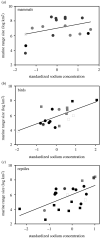Osmoregulatory ability predicts geographical range size in marine amniotes
- PMID: 33823670
- PMCID: PMC8059505
- DOI: 10.1098/rspb.2020.3191
Osmoregulatory ability predicts geographical range size in marine amniotes
Abstract
Species that are distributed over wide geographical ranges are likely to encounter a greater diversity of environmental conditions than do narrowly distributed taxa, and thus we expect a correlation between size of geographical range and breadth of physiological tolerances to abiotic challenges. That correlation could arise either because higher physiological capacity enables range expansion, or because widely distributed taxa experience more intense (but spatially variable) selection on physiological tolerances. The invasion of oceanic habitats by amniotic vertebrates provides an ideal system with which to test the predicted correlation between range size and physiological tolerances, because all three lineages that have secondarily moved into marine habitats (mammals, birds, reptiles) exhibit morphological and physiological adaptations to excrete excess salt. Our analyses of data on 62 species (19 mammals, 18 birds, 24 reptiles) confirm that more-widely distributed taxa encounter habitats with a wider range of salinities, and that they have higher osmoregulatory ability as determined by sodium concentrations in fluids expelled from salt-excreting organs. This result remains highly significant even in models that incorporate additional explanatory variables such as metabolic mode, body size and dietary habits. Physiological data thus may help to predict potential range size and perhaps a species' vulnerability to anthropogenic disturbance.
Keywords: distribution; marine; osmoregulation; salinity; tetrapod.
Figures


Similar articles
-
Effects of oceanic salinity on body condition in sea snakes.Integr Comp Biol. 2012 Aug;52(2):235-44. doi: 10.1093/icb/ics081. Epub 2012 Jun 18. Integr Comp Biol. 2012. PMID: 22710931
-
How salinity and temperature combine to affect physiological state and performance in red knots with contrasting non-breeding environments.Oecologia. 2015 Aug;178(4):1077-91. doi: 10.1007/s00442-015-3308-4. Epub 2015 Apr 9. Oecologia. 2015. PMID: 25851406
-
The physiology of hyper-salinity tolerance in teleost fish: a review.J Comp Physiol B. 2012 Apr;182(3):321-9. doi: 10.1007/s00360-011-0624-9. Epub 2011 Oct 28. J Comp Physiol B. 2012. PMID: 22033744 Review.
-
Evaluating dispersal potential of an invasive fish by the use of aerobic scope and osmoregulation capacity.PLoS One. 2017 Apr 19;12(4):e0176038. doi: 10.1371/journal.pone.0176038. eCollection 2017. PLoS One. 2017. PMID: 28423029 Free PMC article.
-
Salinity tolerances and use of saline environments by freshwater turtles: implications of sea level rise.Biol Rev Camb Philos Soc. 2018 Aug;93(3):1634-1648. doi: 10.1111/brv.12410. Epub 2018 Mar 25. Biol Rev Camb Philos Soc. 2018. PMID: 29575680 Review.
Cited by
-
From the Field to the Lab: Physiological and Behavioural Consequences of Environmental Salinity in a Coastal Frog.Front Physiol. 2022 Jun 2;13:919165. doi: 10.3389/fphys.2022.919165. eCollection 2022. Front Physiol. 2022. PMID: 35721550 Free PMC article.
References
-
- Carvajal-Quintero J, Villalobos F, Oberdorff T, Grenouillet G, Brosse S, Hugueny B, Jézéquel C, Tedesco PA. 2019. Drainage network position and historical connectivity explain global patterns in freshwater fishes' range size. Proc. Natl Acad. Sci. USA 116, 13 434-13 439. (10.1073/pnas.1902484116) - DOI - PMC - PubMed
-
- Saupe EE, Myers CE, Peterson AT, Soberón J, Singarayer J, Valdes P, Qiao H. 2019. Non-random latitudinal gradients in range size and niche breadth predicted by spatial patterns of climate. Glob. Ecol. Biogeogr. 28, 928-942. (10.1111/geb.12904) - DOI
Publication types
MeSH terms
Associated data
LinkOut - more resources
Full Text Sources
Other Literature Sources
Medical

